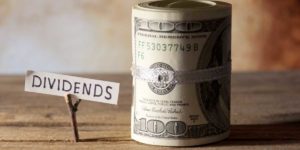Dividends: What are They and Why Do They Matter?
This is a guest post from DollarBreak.com
Many people consider investing in the stock market to help meet their financial goals, but they are unaware of the importance of dividends. Here we’ll explore what dividends are and why they matter to even casual investors.
The Dividend Basics:
In simple terms, dividends are a payment made by companies to the owners of its stock. This is a way for the company to distribute revenue back to its investors, and it is just one of the ways that you can earn a return from your investment.
Here in the United States, dividends are typically paid quarterly, but some are paid semi-annually or monthly. Each dividend is paid for each stock share. So, if you own 50 shares in a company and it is paying $3 in dividends, you will receive $150.
There are several types of dividends that include:
Before you can calculate opportunity cost of your stock investments, it is crucial that you understand how dividends work. Generally, companies pay dividends in cash to brokerage accounts, but you may receive dividends in the form of new stock shares.
Why Are Dividends Important?
According to US News, with interest rates at historic lows, unemployment at its lowest in 50 years, and ten year Treasury yields at just 1.8%, income investors are struggling to find a decent source of yield. This is why it is crucial to understand the implications of dividends.
While many people only look at the index levels, when you consider the dividends, the figures sharply jump, highlighting the power to amplify your returns. For example, if you look at the performance of the S&P 500 over the past 50 years, you will see there has been an average annual increase of 6.5%, but if you add in the dividends, this increases to 9.75%. On a $1,000 investment, this increases the value to almost $115,000 over that period.
According to Investors.com, the stability of dividends reflects a steady track record and the sound financial health of a company. It highlights that the company is working hard to ensure its stock is attractive to both existing and new investors. If a company has a stable performance, it is more likely to offer steady or even rising dividends, so by assessing past performance; you can have an indication of future payments.
Calculating Dividend Yield:
If you’re reading financial websites, you’re likely to see reports on the dividend yield of the company. This is a measurement of the annual dividend divided by a certain day’s stock price. A dividend yield provides a more accurate comparison of stocks.
For example, if a $10 stock is paying $0.10 quarterly, it will have the same yield as a $100 stock that pays $1.00 quarterly. In both cases, the yield is 4%.
The stock price and yield are inversely related; as one goes up, the other will go down. There are two ways for dividend yields to go up:
One of the best dividend yields for 2019, making it a good prospect for investors is TC Energy Corp. This company has made steady progress to reach a five year high at the end of 2019 and a dividend yield of 4.4%
Another good example is Duke Energy Corp that had modest gains in 2019, but is anticipated to have greater growth in 2020, due to progress on the Atlantic Coast Pipeline. This company offered investors an impressive 3.9% dividend yield.
Generally, anything that is above a 4% yield needs to be carefully considered, as it may indicate an unsustainable dividend payout. However, there are some exceptions, such as real estate investment trusts that pay 5% to 6%, but still have growth potential.
Don’t Forget Your Potential Tax Burden
Finally, you need to consider the potential tax implications of your dividends. Dividend income can be taxed in different ways depending on if it is qualified or nonqualified.
Qualified dividends are tax at a lower long term capital gains rate rather than the higher rate used for regular income. Eligibility to this special rate requires the dividend must be paid by either:
Additionally, the stock must have met certain holding period requirements. If you’re in the 10% or 12% tax bracket, qualified dividends are tax free. There are different rates for other tax brackets.
Non qualified dividends do not meet the above requirements and are treated in the same way as short term capital gains. This means that your dividends will be taxed in the same way as your regular income.
So, Are Dividends That Important?
Dividends are a way for companies to give revenue back to investors, so they are one way you can earn a return on your investment. Measuring dividend safety can provide a good indicator of the stability of an investment. By checking the payout ratio, or the amount of net income that makes up the dividend payments, is a quick way to assess the company performance.
Since all dividends need to be authorized by the company, you can assess the financial situation. You can find the payout ratio on financial websites, and generally, the payout ratio should be less than 80%. If the payout is higher, your potential dividend could be in trouble, so it may be a stock to be avoided.
Be sure and follow me on your favorite social media platform:
MoreDividendsdotcom on Facebook
@MoreDividends on Twitter
If you would like to receive an email whenever I publish a new article:







Hello ,
I’m a german so my english is not the best …. this is one of the first comments on a website outside from Germany ….. I am also a Dividend investor and wish you all the best … great blog … I come back …
Thanks a lot for the inspiration
Yours sincerelly
Uwe